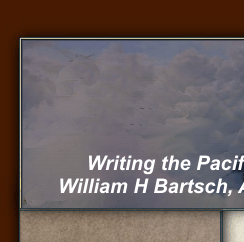
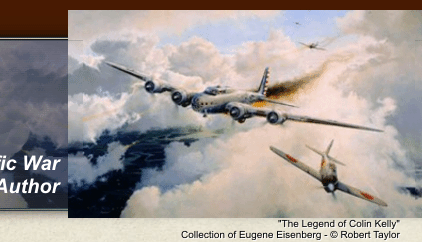



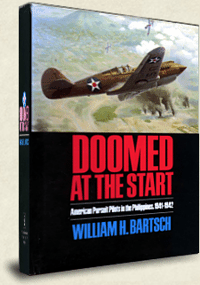 |
|
|
|
| Reviews: Pacific Wrecks; Stone & Stone - An online database of WORLD WAR II books and information |
Doomed at the Start: American Pursuit Pilots
in the Philippines, 1941-1942
During the first three days of the Japanese assault on American Pacific bases in December of 1941, the 24th Pursuit Group, the only Army Air Forces unit of interceptor aircraft in the Philippines, was almost destroyed as an effective force. Yet the Group's pilots -- doomed from the start by their limited training, an inadequate air warning system, and lack of familiarity with the few flyable Pursuit planes they had left -- fought on against immensely superior numbers of Japanese Army and Navy fighters.
This book is the first complete account of the experiences of a group a American pursuit pilots who fought the same enemy in the same period with virtually the same aircraft as the heralded Flying Tigers in China. It details the operational record of the Philippines pilots over the five-month campaign from December 1941 to May 1942.
The story is told from the standpoint of the individual flyers and enlisted men of their squadrons rather than that of the "brass", whose often ill-founded command decisions frequently put their men's lives at unnecessary risk. The day-by-day account has been derived mainly from interviews, diaries, and personal records of the participants, matched against Japanese records. The book fills a wide gap in our knowledge of what really did happen to the Far East Air Force in in the ill-fated Philippines campaign
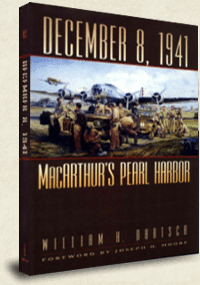 |
|
|
|
| Reviews: Detailed review by Charles C. Kolb of the National Endowment for the Humanities. |
December 8, 1941: MacArthur's Pearl Harbor
Ten hours after the attack on Pearl Harbor, "another Pearl Harbor" of even more devastating consequence for American arms occurred in the Philippines, 4,500 miles to the west. On December 8, 1941, at 12:35 p.m., 196 Japanese Navy bombers and fighters crippled the largest force of B-17 four-engine bombers outside the United States and also decimated their protective P-40 interceptors. The sudden blow allowed the Japanese to rule the skies over the Philippines, removing the only effective barrier that stood betweeen them and their conquest of Southeast Asia. This disastrous event has been called "one of the blackest days in American military history.
How could the Army commander in the Philippines -- the renowned Lt.Gen. Douglas MacArthur -- have been caught with all his planes on the ground when he had been informed in the small hours of that morning of the Pearl Harbor attack and warned of the likelihood of a Japanese strike on his forces? This book attempts to answer this and other related questions, drawing on 25 years of research into American and Japanese records and interviews with many of the participants themselves,who in many cases provided diaries and memoirs to the author. Details of the attack itself are preceded in the first eight chapters by an account of the hurried American build-up of air power in the Philippines after July 1941 juxtaposed with details on Japanese planning and preparations for this opening assault of its Southern Operations. The story is told mainly at the level of the individual participants, American and Japanese alike, but political and strategic aspects are also included to put it in broader context. This is the first time this subject has been given full book-length treatment.
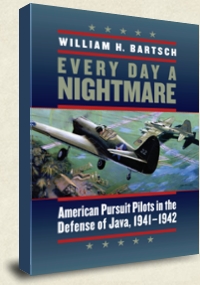 |
|
|
|
| Reviews: Detailed review by Bill Stone with Stone & Stone Books. |
Every Day a Nightmare: American Pursuit Pilots in the Defense of Java, 1941-1942
In early January 1942, the Japanese were about to launch the third -- and final -- phase of their Southern Operations: to seize the Dutch East Indies and its oil riches, absolutely essential to fuel their relentless war machine. Against the impending Japanese juggernaut moving south from the Philippines and heading for the key island of Java, the Dutch would only be able to mount a feeble force of woefully-obsolete fighters and bombers.
To fill this void, the War Department in Washington now decided to send to the Indies a group of American Army pursuit pilots being assigned to five so-called "provisional pursuit squadrons" in the hope of stemming the expected Japanese aerial attacks on Java, their ultimate objective. Nine out of ten of the 124 pilots being sent had arrived in Australia only a month earlier from the U.S. They were intended originally as reinforcements for Lt. Gen. Douglas MacArthur's Far East Air Force in the Philippines, but were now being diverted to the Java campaign. Except for 14 Philippines veterans, they were fresh graduates of flying school with little if any experience operating their aircraft, the Curtiss P-40. Over the next weeks, only one third ever made it to Java, the rest wiping out their ships in accidents on the way to the jumping-off field at Darwin, shot down over Darwin or Bali, or lost in the sinking of the seaplane tender USS Langley that was carrying 33 of the pilots by sea to Java. Those who did reach their secret base on Java saw their numbers dwindling daily as the Japanese air assault intensified in February 1942. As the end of the Java campaign approached, the survivors felt they were being sacrificed for no purpose and were anxious to be evacuated, over the objections of the Dutch. Except for a partial account by a Chicago war correspondent, this story has never been related before.
 |
|
|
The Old Breed of Marine: A World War II Diary
(Abraham Felber, with Franklin S. Felber and William H. Bartsch)
As the 1st Sgt. of Headquarters Battery, 11th Marine Regiment, 1st Marine Division, Abraham Felber kept a record of events transpiring around him from January 1941 through December 1945, including of the Regiment's operations during the Guadalcanal and Cape Gloucester campaigns. The detail provided is unmatched in any published source on the 11th Marines. With the encouragement of Bartsch and Felber's son, Abe Felber agreed to have his diary published, necessarily in abbreviated form. Bartsch provided a historical background note and annotations and prepared the index.
 |
||
|
||
| Reviews: Don DeNevi in Leatherneck, January 2015, p. 59, and Bill Stone- www.books.stonebooks.com |
Victory Fever on Guadalcanal: Japan's First Land Defeat of World War II
In the small hours of Friday, August 21, 1942, a fanatical force of some 900 just-landed Japanese soldiers from the 28th Infantry Regiment under the command of Col. Kiyonao Ichiki tried to cross the Tenaru River (actually, Alligator Creek) on the north coast of Guadalcanal with the aim of re-occupying the airfield the Japanese had lost to the Marines following the American landing on Guadalcanal two weeks earlier. Opposing them across the Tenaru were Marines of Lt. Col.Edwin Pollock's 2nd Battalion, 1st Marine Regiment, reinforced with a battery of 37 mm guns. Most of them were "Pearl Harbor volunteers" in their late teens with only months of training prior to being shipped off to the Pacific.
Expecting a quick and easy victory over the defenders, the combat-seasoned Japanese -- imbued with "Victory Fever" -- were wiped out almost to a man, with the 1st Regiment's 1st Battalion carrying out the cleaning up operation that afternoon. Juxtaposed with detailed personal experiences of the Marine participants, those of many of their Japanese adversaries are also presented in this, the first book-length account of the landmark battle, Japan's first land defeat of the Pacific War.
| Home | | | | | | | | | | | | | | | | | Contact | |||||||